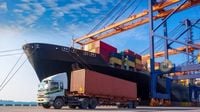In 2023, EU countries exported €245 billion worth of transport services to countries outside of the EU, marking a decline of 21.5% compared with 2022. This fall was mainly due to a decrease in sea transport. However, sea transport remained the largest services category, accounting for half of the exports at €122 billion (49.7%). Air transport ranked second with €71 billion (28.8%), followed by other modes of transport with €40 billion (16.5%), and postal and courier services with €12 billion (5.0%).
According to statistics from Eurostat, in 2023, air transport was the only transport service that experienced growth in value, increasing by 8.5% compared with 2022. In contrast, sea transport saw a significant decline of 36.8%, while other modes of transport and postal and courier services recorded declines of 3.5% and 3.3%, respectively.
The largest exports to extra-EU countries in 2023 were directed towards the United States, which received €43.1 billion (17.6% of the total), followed by the United Kingdom with €37.4 billion (15.2%), and Switzerland with €22.4 billion (9.1%). Other notable partners included China, receiving €15.7 billion (6.4%), and Singapore, with €11.3 billion (4.6%).
Sea transport represented the majority of exports to Singapore (83.2%) and China (65.1%) in 2023. When it came to American customers, sea transport and air transport accounted for almost equal shares of EU exports, at 45.7% and 45.6%, respectively. Trade with the United Kingdom exhibited a more balanced distribution, with air transport accounting for 37.2%, other modes of transport for 35.2%, and sea transport for 22.2% of exports of transport services. Notably, other modes of transport (43.4%) and sea transport (39.7%) had the biggest share of exports of transport services to Switzerland.
Meanwhile, Uzbekistan's participation in the China Import and Export Fair has showcased the country’s growing role in international trade. Thousands of companies from over a hundred countries participated in this large-scale event, which took place recently. The Uzbekistan delegation’s pavilion particularly attracted attention, featuring a wide array of leather and shoe products and accessories.
During the fair, the Uzbekistan delegation met with representatives from several leading Chinese companies. Notable among them was Qifeng Leather, which expressed interest in cooperating on the supply of raw materials and the production of new materials. Discussions also included projects to establish joint ventures in Uzbekistan, as well as modern design and educational laboratories with Mudiya and Jinjiang Mudiao Shoes. Logistics, export infrastructure, and digital customs systems were also topics of discussion with Trimax International representatives.
Chinese manufacturers proposed the joint launch of new production facilities, highlighting the fair as an important platform for discussing technological achievements and prospects for industrial cooperation. The Uzbekistan delegation presented information about clusters, special industrial zones, favorable conditions for investors, and opportunities in the leather and footwear industry.
In the United States, a nationwide export slump is impacting the agricultural sector, particularly affecting top products such as soybeans, corn, and beef. Trade data indicates a significant decline in U.S. exports, particularly to China, which began in January and has extended to most U.S. ports. According to trade tracker Vizion, the Port of Portland, Oregon, has experienced a staggering 51% decrease in exports, while the Port of Tacoma, Washington, has seen a 28% decrease.
Some ports have only seen minor decreases, such as the Port of Houston and the Port of Seattle, which are down by 3% and 3.5%, respectively. However, the overall trend shows that nearly all U.S. exports have taken a hit. The Port of Los Angeles, for instance, has reported declines of over 17%, while the Port of Savannah, Georgia, the top U.S. port for exporting containerized agricultural goods in 2025, is down 13%. The Port of Norfolk, Virginia, is also down by 12%.
As U.S. imports continue to decline, port data tracked by Vizion has shown a 43% week-over-week drop in containers from late April. Kyle Henderson, CEO of Vizion, remarked, "We haven't seen anything like this since the disruptions of summer 2020." The situation has prompted retailers to urge consumers to buy sooner rather than later, as the number of inbound container ships to the Port of Los Angeles is expected to sharply drop in May, leading to a 15%-20% decrease in U.S. container imports from Asia.
Bank of America has indicated that the ratio of retail inventories to monthly sales is not especially high, suggesting that supply disruptions may be looming. Many retailers only have one to two months of sales in inventory, meaning any unforeseen demand or supply disruptions could quickly impact available goods and prices.
In a critical period for the holiday shopping season, retailers are urged to lock in capacity now to avoid scrambling later. Tim Robertson, CEO of DHL Global Forwarding, emphasized that the brands that treat June as a strategic deadline will be better positioned to meet consumer demand.
In Norway, despite looming tariffs, seafood exports have reached a record high value in April 2025. The value of exports increased by 2% compared to last year, with Norway exporting seafood worth NOK 58.5 billion (approximately €5 billion) so far this year, marking a 7.3% increase compared to the same period last year. Salmon accounted for 71% of the export value, with NOK 10 billion (approximately €856 million) worth exported in April alone.
Christian Chramer, CEO of the Norwegian Seafood Council, noted that the growth is due to increased export volumes and rising demand for Norwegian salmon in key markets such as the USA and China. In addition to salmon, exports of Arctic king crab have also shown strong growth, with Norway exporting 97 tonnes of king crab worth NOK 41 million (€3.5 million) in April, representing a remarkable increase of 110% compared to the same month last year.





